Airbrushing is an amazing art form that uses a stream of atomized paint for artistic effect. A stream of airborne particles can make paint jobs look really unique and cool but you can’t help but wonder, should you be concerned about breathing this in?
I have found through my research that many of the resources out there on the internet make a blanket statement that airborne airbrush particles are always dangerous and that you will surely suffer tremendous health consequences if you don’t wear a mask at all times
This contradicts my anecdotal experience that many airbrushers I have worked with over the years don’t always wear masks when they work.
As an airbrush artist that is invested in my long-term health, I wanted to get to the bottom of this and determine if you really need a mask when airbrushing.
As a general rule, you should wear a mask or respirator when airbrushing. However, if proper ventilation is present, and the paint is established as non-toxic, a mask is not needed to airbrush safely.
General rules are great, but I think it is more valuable to know the health hazards of airbrushing. Instead of just telling you a blanket rule to follow, this article aims to give you the information you need to evaluate the risks and make your own decisions about wearing a mask.
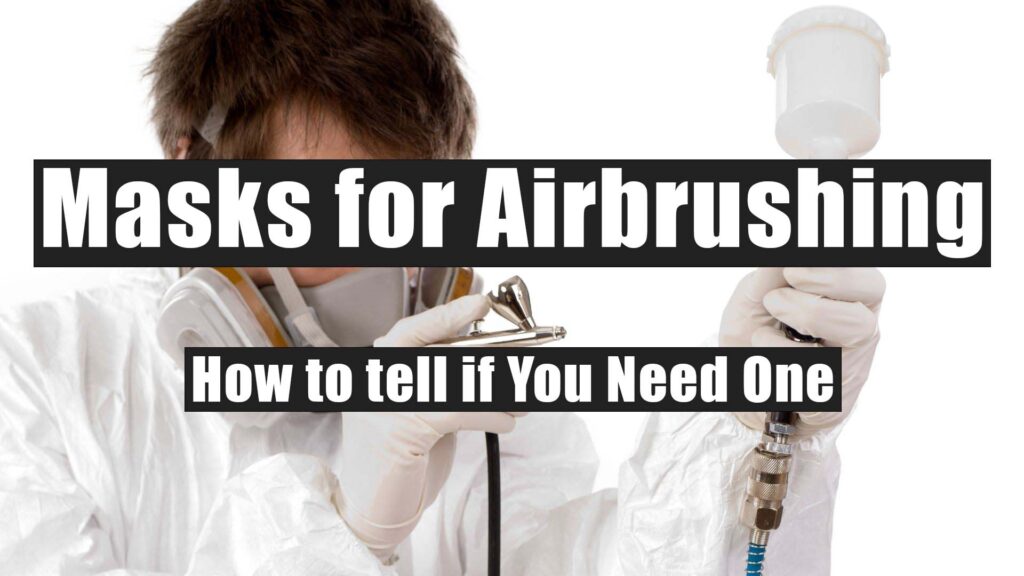
Are Airbrush Fumes Toxic?

The short answer to whether airbrush fumes are toxic is, “it depends”. It depends on what you mean by airbrush fumes and what kind of fumes they are.
Airbrush Fumes vs. Atomized Particles
Much research on paint toxicity refers to hazardous exposure to fumes. While paint fumes are certainly a concern, atomized paint particles are usually what people refer to when they talk about “airbrush fumes”.
Atomization is the process of breaking down paint into tiny droplets by combining a low speed stream of liquid with a high speed stream of air.
Air atomization is what airbrushes use to achieve an airborne stream of paint particles. check out this article to learn more about atomization and how airbrushes work.
Tiny particles of paint droplets can produce one kind of hazard, while the chemical fumes of the paint can produce another.
So when you’re guarding against the potential dangers of airbrush paint inhalation, you’re really dealing with two different hazards – airborne particulate and chemical fumes.
Some paint particulate and fumes are hazardous to your health while another paint isn’t, that’s why it’s so important to make sure you know what’s in your paint.
How to Know What’s in Your Airbrush Paint
When dealing with atomized paint particles, it is always worth investigating anything that you spray out of your airbrush. The best way to do this is by looking at the SDS (Safety Data Sheet) – a document that lists information relating to occupational safety and health for the use of various substances and products.
Under the OSHA (Occupational Safety and Health Administration) Hazard Communication Standard, health hazards will be marked on the SDS with classification and category – denoting the type of hazard and the severity.
Basically, the system tells you how a substance could hypothetically poison you (the hazard classification) and how poisonous it is (the category).
Classifications are pretty self-explanatory and include things like skin corrosion or carcinogenicity.
Categories range from 1 to 4, with 1 being the most deadly and 4 being the mildest. Category 0 means that it is not classified as a hazardous substance.
Chemical distributors, manufacturers, or importers are required by law in the US to provide SDSs to downstream users for hazardous materials. So you should always be able to find one for your airbrush paint somewhere.
If you can’t find the SDS online, don’t hesitate to contact the manufacturer to request a copy.
Toxic Chemicals Found in Paint
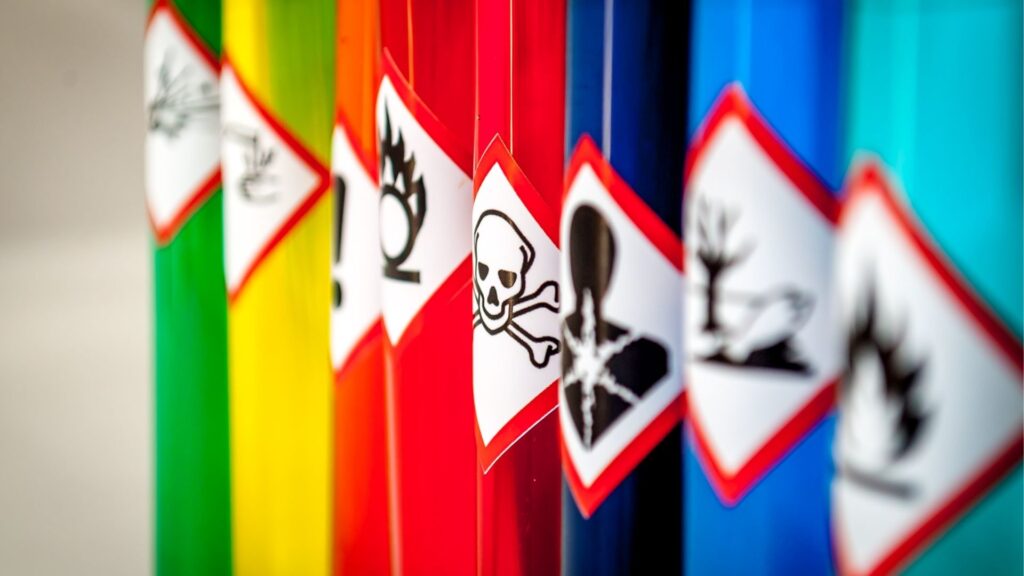
Once you know where to look for toxic chemicals, keep an eye out for some of these common hazardous substances:
- Benzene is a known carcinogenic (causes cancer) typically found in oil-based paints among other arts and craft supplies such as dry erase markers and glue. This one is especially worthwhile to keep an eye out for as it is classified in the VOC category (volatile organic compounds) – according to the American Lung Association, VOCs may also cause nervous system and organ damage.
- Isocyanates are commonly found in most automotive paint. Its used as a key ingredient to make polyurethane based paints. It is a sensitizer which means it can cause hypersensitivity in your lungs which can lead to asthma and other health complications.
There are many other toxic chemicals out there, so always be sure to check the SDS before airbrushing with a new substance.
Water-based Paint vs. Solvent-based Paint
Paint is made of 4 elements; resin, additives, pigments, and a dissolving agent (solvent). The big difference between toxic paint and non-toxic paint often comes down to the type of solvent.
Many paint lines will use chemicals that allow it to evaporate quickly and have uniform characteristics at any temperature and humidity – these are commonly referred to as solvent-based paint.
Paint solvents are usually toxic so check the SDS and take any necessary precautions with them.
Water-based paint uses water as a solvent to avoid toxicity and smell – which makes it very user-friendly.
Let’s take a look at a solvent-based airbrush paint and a water-based airbrush paint to see the difference:
Just picking a common solvent-based paint, the SDS for House of Kolor Shimrim Kandys paints a pretty bleak picture. Its a category 1 skin sentization, category 2 skin corrosion/irritation, category 1B toxic to reproduction – pretty nasty stuff.
Conversely, the water-based acrylic airbrush paint that I use always use has no mention of hazardous inhalation risk – here’s the SDS for Createx Airbrush Colors. Its a category 0 across the board for every hazardous classification.
Generally speaking, solvent-based paint is hazardous to your health while water-based paint is non-toxic and completely safe. In fact, water-based airbrush paint like Createx Airbrush Colors and Wicked Colors are so safe that they both work great for airbrush body painting.
Water Based Non-toxic Createx Airbrush Colors
Top Pick: Non-toxic water-based paint
After going through the SDS for these paints, it becomes apparent that you should really protect yourself when you airbrush with solvent-based paints. Even if you use proper ventilation, the risk is too great to expose yourself to those nasty chemicals.
Conversely, water-based airbrush paint is so non-toxic that it would be hard to hurt yourself with it if you tried. Therefore, my personal conclusion is that a mask is not really necessary when painting with non-toxic paint.
I will however use a mask when painting in an enclosed area where proper ventilation is not possible and airborne particulate can start to accumulate.
How to Airbrush Inside Safely
When you’re airbrushing inside, the risk of particulate building up in the air is always present. Of course, there will be varying levels of paint particles floating around depending on the air pressure of your system, the distance you are spraying from the substrate etc.
However, proper precautions should always be taken.
ARTICLE: Is Airbrushing Messy? | How to Keep Your Workspace Clean and Tidy
To airbrush inside safely, always make sure that you have good ventilation, and/or a mask or respirator.
The Best Kind of Mask for Airbrushing
When choosing the best kind of mask for airbrushing, it’s important to establish the difference between a mask and a respirator.
Basically, respirators provide a tight seal on the user’s face while a mask only covers the nose and mouth.
Here’s how OSHA defines a respirator:
“Respirators come in various sizes and must be individually selected to fit the wearer’s face and provide a tight seal. A proper seal between the user’s face and the respirator forces inhaled air to be pulled through the respirator’s filter material and not through gaps between the face and respirator”
OSHA (Occupational Safety and Health Administration)
Masks are simply not designed to protect against the inhalation of all airborne contaminants.
For this reason, it is recommended that a respirator be used when the airbrush paint contains any toxic properties.
Types of Respirators
There are two main types of respirators: air-purifying respirators which filter airborne contaminates, and atmosphere supplying respirators which supply clean air from another source.
Atmosphere supplying respirators are used in some very toxic environments when workers are constantly exposed to hazardous substances, but they are kind of overkill for most airbrushing applications – they require air tanks and are far more complex than is really needed.
For simplicity, just focus on the air-purifying variety of respirators.
Respirators have varying filter abilities which are denoted using an APF (Assigned Protection Factor).
The higher the APF score of a respirator, the greater level of protection it will provide. For example, a respirator that has an APF of 10 will reduce your exposure to 1/10 the concentration of the contaminate in the air.
Air-purifying Respirators
Air-purifying respirators fall into two categories – half-face and full-face. For airbrushing, focus on half-face respirators. Full-face respirators are used in some situations when consistent exposure to eye-irritating chemicals are present.
Full-face is also kind of overkill for most airbrushing applications as you shouldn’t be reaching particulate saturation levels that will risk eye irritation.
Therefore, the half-face respirator should suit your purposes just fine.
Of the half-face variety, there are 2 classifications of respirators:
1. Filtering Facepiece Respirators

- air-purifying respirators
- Covers the nose and mouth
- Protects against airborne particles but not gas and vapor
- Typically one-time use
- N95 are a kind of filtering facepiece respirator
2. Half-facepiece Elastomeric Respirator
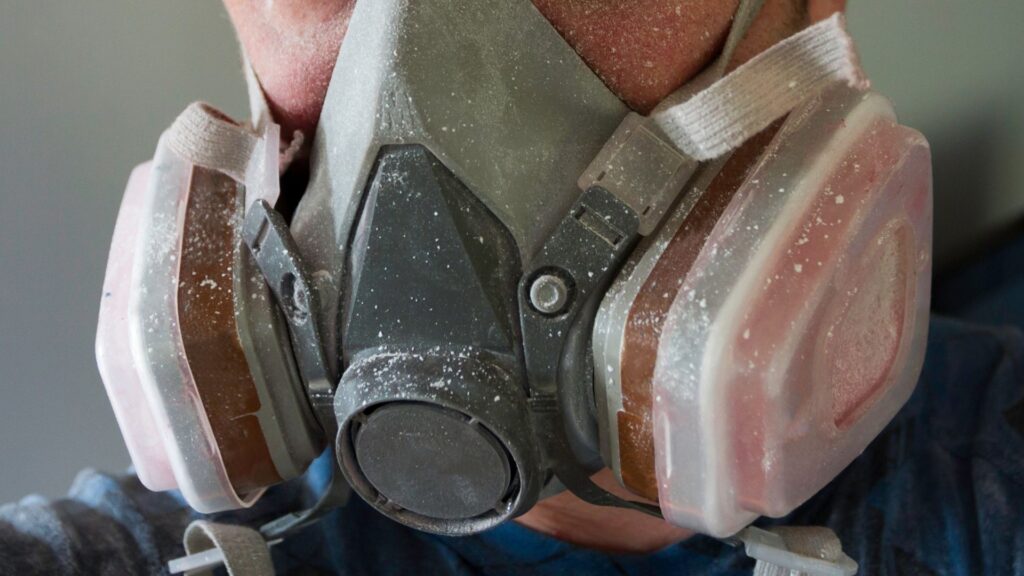
- Tight-fitting air-purifying respirator
- Replaceable filter cannistors
- Protects against airborne particles and vapor/fumes (if proper filter catridge/canister is used)
- Reuseable
Because filtering facepiece respirators only protect against particulate inhalation, they are great for cutting down on excessive irritating non-toxic airbrush particulate from water-based paints. However, they will not provide adequate protection against substances with hazardous fumes such as solvent-based paint.
Half-facepiece Elastomeric Respirators provide protection against airborne particulate and vapor/fumes (given the proper filter cartridge/canister). Therefore it is recommended that this kind of facemask be used for solvent-based airbrush paints at all times.
Respirator Filter Classification
Respirator filters fall into different categories that describe the strength of their filtering ability.
This classification includes a letter and a number. The letter defines the filter’s resistance to oil:
- “N” means not resistant to oil
- “R” means somewhat resistant to oil
- “P” means strongly resistant to oil
The number on a filter classification denotes the percentage of harmful contaminates that it can remove from the air:
Example: The N95 removes at least 95% of airborne particles.
Some respirator filters are also combined with fume/vapor protection layers. It is especially important when airbrushing with solvent-based paint to use filter cartridges/canisters with this capability. This layer uses a chemical reaction to neutralize or absorb the hazardous chemical before it reaches your lungs
This OSHA color coding system classifies what chemical vapors are filtered using a given cartridge/canister:
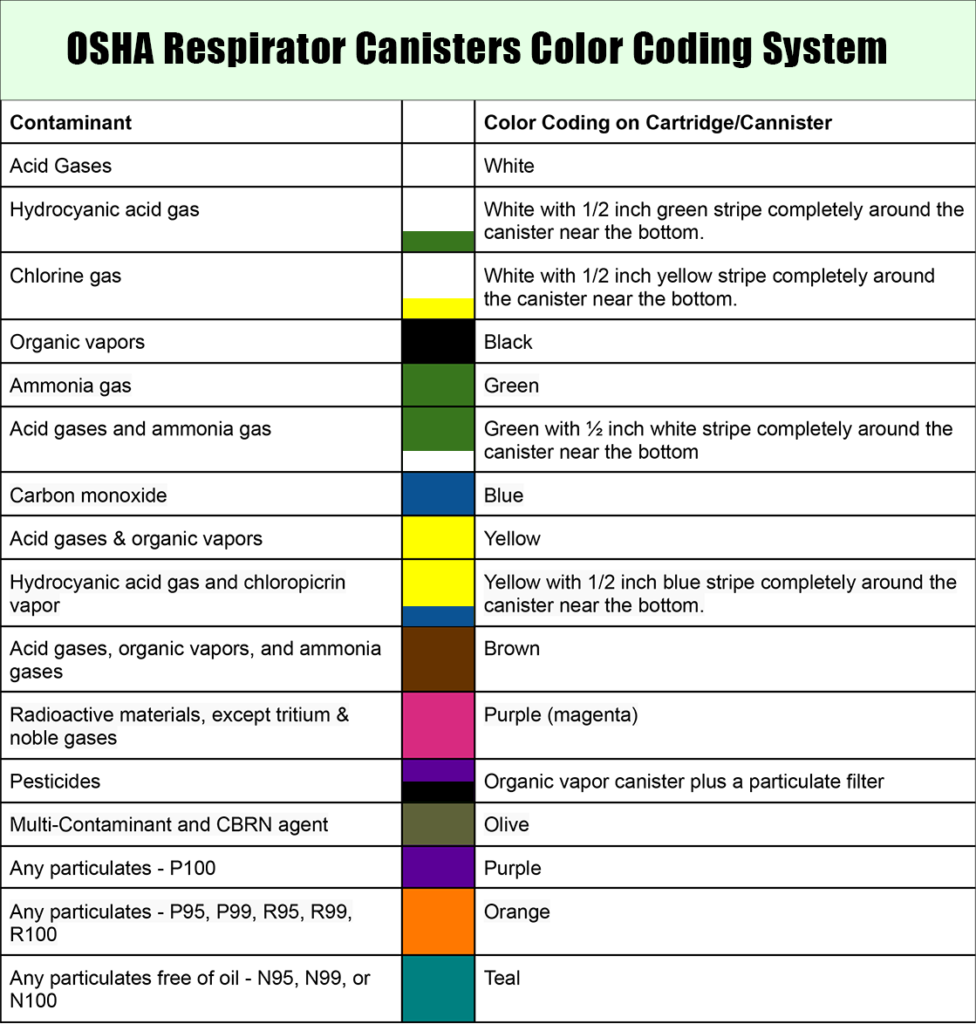
For airbrushing with hazardous chemicals such as solvent-based paints, you’ll want to use a filter cartridge/canister that has a high particulate filtering ability and protects against organic vapors – this will give you the best protection against the atomized paint droplets floating around in the air and also against the chemical fumes they might produce.
The Best Respirator for Airbrushing
When you’re airbrushing with solvent-based paints, a half-facepiece elastomeric respirator with an organic vapor P100 cartridge/canister is your best option.
3M Quick-latch 6503QL
3M has some great options for half-face respirators, but the best one I’ve tried is the 6503QL. This respirator is very comfortable, makes a great seal on your face, and has a quick-latch feature which makes it very easy to take on and off with only one hand. It’s compatible with all 3M bayonet-style cartridges and filters (the most common kind that 3M produces) so getting replacements is super easy.
3M Multi-Gas Vapor P100
The best 3M respirator filter you can get is the 3M Multi-Gas Vapor cartridge/filter P100. This cartridge filters out 99.7% of particulate contaminants and neutralizes a wide range of chemical gases, including organic vapors from solvent-based paints. This filter cartridge/canister really gives you peace of mind because it just covers all your bases.
The Best Mask for Airbrushing
If you’re using a non-toxic water-based airbrush paint in a well-ventilated area, a mask may not be needed. However, if the particulate is bothersome, you can simply use a filtering facepiece respirator as a mask.
3M 8511 Cool Valve N95 Mask
Best All Around Airbrush for Automotive Paint
Most people are probably familiar with the N95 mask by now. This filtering facepiece respirator works great for cutting down on the inhalation of atomized paint particles. The cool flow valve on the 3M 8511 is a little less known feature because it defeats the purpose for slowing the spread of disease. But for airbrushing, this valve works great for making breathing easy and is my personal favorite when I’m working with non-toxic airbrush paint in an enclosed area.
How to Ventilate Paint Fumes and Airbrush Particulate
When deciding if you need to wear a mask for airbrushing, it’s important to evaluate the area that you’re working in first.
In fact, in the NIOSH (National Institute for Occupational Safety and Health) Hierarchy of Controls, PPE (personal protective equipment) is the lowest control on the totem pole, and therefore the least effective.
The hierarchy of controls illustrates the importance of controlling safety hazard as much as possible before resorting to mask wearing. This is why I recommend always airbrushing in well-ventilated areas even when non-toxic airbrush paint is being used.
Here are 4 things you can do to improve the airflow and ventilation in your work area:
Airbrush in an Open Area
When you airbrush in an open area, there is more space for airborne particulate to disperse. Small enclosed areas are not ideal because the particulate from overspray can build up to higher concentrations faster.
Therefore, some of my personal favorite places to airbrush are in large shops, wide-open art studios, or even outside on a nice day.
Of course, not everyone has a large shop or a nice secluded backyard in which to set up their airbrushing stuff and get after it. Sometimes the best you can do is a dingy closet in the back corner of your mom’s basement.
This is ok! There are other controls you can implement to achieve adequate airflow in your airbrushing space.
Fans to Circulate Air
Simple house fans can work well for circulating and moving air around in an enclosed area. This process speeds up the diffusion of particles and prevents a build-up directly around your workspace.
In order for fans to work properly, you have to give the air a place to go. It doesn’t help to move air around in a sealed room when atomized particles are slowly building up. Make sure you open a door or a window, place the fan near it to move fresh air in and contaminated air out.
Airbrush Spraybooths
Master Airbrush Portable Hobby Airbrush Spray Booth
Best Spray Booth for Hobby Airbrushing
If you don’t have a large work area, and there isn’t really anywhere for a fan to push air around, you can always resort to an airbrush spray booth.
Airbrush spray booths are vacuum-powered backdrops that suck overspray away from your work area. A plastic hose feeds the exhaust air from the spray area to an outer window or another room.
These are very popular with hobbyist airbrushers for painting figurines or models because of their size and ease of use.
To summarize, you should wear a respirator for airbrushing with solvent-based paint. Non-toxic water-based paint does not require a mask if you are airbrushing in a well-ventilated area – a filtering facepiece respirator such as an N95 can be used with non-toxic paint if you choose.
Take the time to read and understand the SDS of any substance you spray through your airbrush. Always control for hazards before resorting to personal protective equipment for protection.
If your paint has any hazardous properties at all, use the controls described in this article to reduce your risk of negative health impacts. With adequate ventilation and a properly rated respirator, you should be confident to dive into the amazing world of airbrushing while protecting your health for years to come.







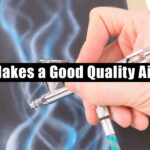
Very informative post. This confirms all the information I have been reading on using an airbrush safely.